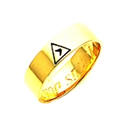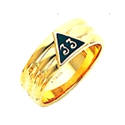|
Scottish Rite Caps
As the White Lambskin is the badge of a Mason, so is the regulation cap the badge of a Scottish Rite Mason.
|
|
Purple Cap The cap of the Sovereign Grand Commander is of circular purple silk.It is surrounded with a purple band slightly darker than the cap itself, and this is trimmed in gold. The band is adorned with laurel vine, leaf, and berry. The cap has a gold cord, which extends across its top, and affixed at both sides by a gold button, which is embossed with a double-headed eagle. The front of the cap is adorned with a slanted purple three-armed Cross of Salem with crosslets, which is trimmed with gold bullion wire. |
|
|
Violet Cap indicates that the wearer is a 33° Sovereign Grand Inspector General. This is the title of an Active Member of The Supreme Council. There is only one Active Member for any one Orient (state, territory, or country). He is the highest-ranking officer of the Rite within his jurisdiction, and, in relation to the Rite, his powers are similar to those of a Grand Master of the Symbolic Craft subject, however, to The Supreme Council and the Sovereign Grand Commander. |
|
|
White Cap with a Scarlet Band indicates a 33° Deputy of the Supreme Council. In Orients (states, territories, or countries) that do not have an Active Member, the Sovereign Grand Commander appoints a "Deputy of The Supreme Council." The Deputy has powers similar to those of a Sovereign Grand Inspector General. However, he has no vote in The Supreme Council and holds his office at the pleasure of the Sovereign Grand Commander. |
|
|
The Grand Cross of the Court of Honour is the highest individual honor that The Supreme Council bestows. It is voted very rarely to Thirty-third Degree Masons only for the most exceptional and extraordinary services. The Grand Cross cap is white with a blue band. On the front is a replica of the Grand Cross jewel, which is composed of a Teutonic Cross, with an embroidered crimson rose with green leaves at its center. |
|
|
White Cap indicates a 33° Inspector General Honorary. The cap of an Inspector General Honorary is of circular white silk. It is surrounded with a white band which is trimmed in gold. It has a gold cord, which extends across its top, and is affixed at both sides by a gold button, which is embossed with a double-headed eagle. The front of the cap is adorned by a slanted red two-armed Patriarchal Cross, which is trimmed with gold bullion wire. |
|
|
Red Cap means a 32° Knight Commander of the Court of Honor (KCCH). The cap of a Knight Commander of the Court of Honor is of circular red silk. It is surrounded with a red band which is trimmed in gold. It has a gold cord, which extends across its top, and is affixed at both sides by a gold button, which is embossed with a double-headed eagle. The front of the cap is adorned by an embroidered version of the Knight Commander Court of Honor jewel, trimmed in gold bullion wire. |
|
|
Light Blue Cap means that the wearer has been a Scottish Rite Mason for fifty years or more. The cap of a 50 year Scottish Rite Mason is of circular blue silk and is surrounded with a similar blue band trimmed in gold. It has a gold cord extending across its top and is affixed at both sides by a gold button embossed with a double-headed eagle. The front is adorned above the band by the numeral 50 surrounded by a green silk embroidered laurel wreath. |
 |
A Black Cap indicates that the wearer has attained the 32nd Degree. The cap of a Master of the Royal Secret is of circular black silk. It is surrounded with a black band which is trimmed in gold. It has a gold cord, which extends across its top, and is affixed at both sides by a gold button, which is embossed with a double-headed eagle. The front of the cap is adorned by a double-headed eagle in gold bouillon, above whose heads is a red triangle, embellished by golden rays, and bearing the numeral 32. |
|
|
Black Bonnet The cap of a Knight of Saint Andrew is a black wool Glengarry bonnet. It is decorated with a red yarn torrie on top with black ribbons attached to the back. The left side of the cap is adorned with a black grosgrain ribbon cockade, upon which is affixed a silver crest badge of the order. Active Knights may wear the Glengarry in place of the conventional 32° black cap during select Scottish Rite ceremonials and special events. |
The Supreme Council has set forth a rule for the correct wearing of the cap. When wearing the cap, it shall be considered to be a part of the apparel of the wearer and shall not be removed.
At the presentation of the flag, the cap shall remain in place, and the members shall stand at attention with the right hand over the heart.
During prayer the cap shall remain in place and the hands and arms shall be crossed as in the 18th Degree.
The wearing of caps is considered proper at Reunions, regularly scheduled meetings, Maundy Thursday services, Easter celebrations, and other official Scottish Rite functions.
Scottish Rite Rings

Fourteenth Degree Ring
To our ancient Brethren, who were members of Knightly Orders, three things in this life were prized above all others - even above life itself - for with the loss of either, life’s aim had failed.
These three things, so dear to the ancient Knight, were the purity of his honor, the integrity of his sword, and the spotlessness of his shield. Honor that never broke faith with anyone, whether man or woman; the integrity of the sword, in never failing to draw it in the defense of innocence and right; the shield never to be sullied by protecting oppression and wrong.
At the death of the Knightly owner, he bequeathed his sword and shield to one nearest and dearest to him, the one he believed would maintain both unblemished.
The Scottish Rite has adopted a symbol that represents the sword, shield and armor of our ancient Brethren, and as clearly marks the profession of Knighthood as did those. This symbol is the Fourteenth Degree Ring, with its motto - "Virtus junxit, mors non separabit" - "Virtue has united, death shall not separate" - to be honorably worn through life, and at death, as was the custom of our ancient Brethren, to be handed down to one most dear, in the belief that it would be kept pure and unsullied. This ring is a plain flat band of gold, having imposed thereon an engraved or enameled plate in the form of an equilateral triangle, and within the triangle the Hebrew letter "Yod."
Many Brethren believe that the ring bearing the double-headed eagle, so generally worn, is the true Scottish Rite ring. This is without authority of the Supreme Council of the Southern Jurisdiction, which recognizes only the two rings of the Fourteenth and Thirty-Third degrees. There is no obligation to wearing the ring with the double-headed eagle; it is beautiful, and although not authentic, is recognized by many who are not even members of our order, as the mark of a Thirty-Second Degree Mason.

Thirty-Third Degree Ring
The ring of the Thirty-Third Degree is a triple one of gold, like three small half-round rings side by side, united into one, not exceeding five-sixteenths of an inch in width. This ring may be plain without any device or mark on the outside of it, or it may have on the outside of it an equilateral triangular-shaped plate with the numerals 33 on same. Engraved within the ring should be the proper inscription, together with the name of the brother and the date on which he received the Degree.








